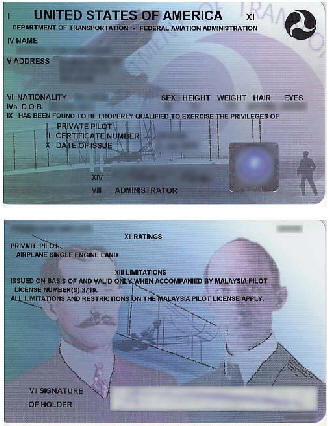
| NEWSROOM |
|
|
 |
|
|
|
|
|
|||
|
By Mike Mitchell |
||||
 |
February 7, 2010 –
FAA pilots who have a paper pilot’s license will need to change the
license to the plastic license by March 31, 2010. Pilots having a paper
license will not be able exercise the privileges of pilot after March
31st.
There are two ways
to replace an airmen certificate. You can request a replacement
certificate at the FAA
website online.
Or you can mail an Application for Replacement of Lost, Destroyed, or
Paper Airman Certificate. You will need to provide your name
|
|||
|
|
||||
|
General Structure
of Certification
Pilots are
qualified to fly at a specific privilege level and in one or more
specific categories of aircraft. Examples of privilege levels found in
most countries are:
• Student: Cannot
fly solo without proper endorsement from a Certified Flight Instructor.
Passenger Carrying is Prohibited.
• Private:
Passenger Carrying no longer prohibited. Cannot be paid or compensated
to fly. Cannot be hired by any operator.
• Commercial: Can
be paid or compensated to fly. Can be hired by operators.
• Airline
Transport: Can act as Captain of an Air Carrier.
Pilot privileges
are also further broken down into category, class, and in some cases,
rating.
Class rating and
Type rating
A category is
defined as "a broad classification of aircraft", broken down into
Airplane, Rotorcraft, Glider, and Lighter-Than-Air. A class is defined
as "a classification of aircraft within a category having similar
operating characteristics", which include single engine, multi-engine,
land, water, gyroplane, helicopter, airship, and free balloon. In
addition, a type rating is required for aircraft over 12,500 pounds, or
aircraft which are turbojet powered. Further endorsements are required
for high performance (more than 200 horsepower), complex (retractable
landing gear, flaps, and a controllable pitch propeller), or tailwheel
equipped aircraft, as well as high altitude operations.
Most Private Pilot
certificates are issued as "Private Pilot:
The
typical order in which a pilot obtains ratings is:
• Private Pilot
(35–40 hours minimum required)
• Instrument
Rating (40–50 hours minimum required)
• Commercial Pilot
(250 hours minimum required)
• Airline
Transport Pilot or ATP (1500 hours total time required) See (Pilot License Certification Requirements Under Review By The FAA) |
| ©AvStop
Online Magazine
Contact
Us
Return To News
|
|